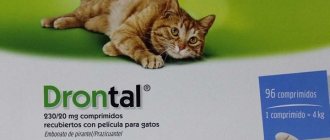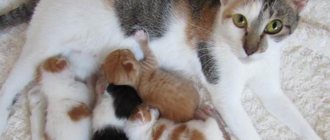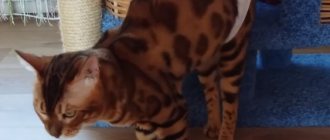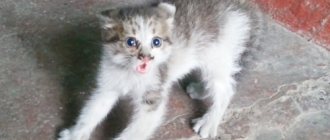Complete information on abortion in cats. Medicines and their side effects.
In veterinary medicine, there are various ways to prevent unwanted pregnancy in a cat. There may be several reasons to resort to such measures: 1. The owner’s desire 2. Testimony from the veterinarian.
Termination of pregnancy in cats is quite a lot of stress for her body. If you do not want offspring from a cat, it is better to take care of this in advance - sterilize or use hormonal drugs for a while, for example, Covinan.
Abortion drugs can have serious side effects and you must be 100% sure that your cat has had intercourse with a male cat and can become pregnant or has already conceived. Pregnancy can be confirmed by a veterinarian approximately 20-22 days after conception. The presence of fetuses in the cat's womb can be diagnosed by abdominal ultrasound or palpation. If medication is given unnecessarily, it can lead to serious illness. In veterinary medicine, there are three types of drugs for terminating unwanted pregnancies in cats: estrogens , prostaglandins and glucocorticoids . Estrogens are drugs that act on a fertilized egg and prevent it from attaching to the uterus. If you give this drug immediately after sexual intercourse with a cat, when pregnancy has not even been confirmed, then in 98% of cases, pregnancy will not occur. But your cat is subject to various side effects after taking estrogen.
These include: 1. Suppression of bone marrow function.
This condition results in severe anemia when the levels of white blood cells and platelets drop sharply. This can occur two weeks to two months after the drug is administered and is usually irreversible and ultimately fatal. 2. Pyometra is an infection in the uterus of a cat. This infection is generally difficult to treat with antibiotics and often requires removal of the ovaries. 3. Infertility. The most commonly used estrogens are: Estradiol cypionate Diethylstilbestrol Prostaglandins are a class of drugs that reduce progesterone levels in a cat, resulting in termination of pregnancy. These medications are used when a cat is confirmed to be pregnant by a veterinarian. Prostaglandins are safer than estrogens and are preferred by many veterinarians. The most serious side effects after using prostaglandins are pyometra and various uterine infections. Just as with estrogens, it may be necessary to remove the ovaries if antibiotics do not help. There have been no reported cases of infertility in cats following the use of prostaglandins.
The most common prostaglandins: Fluprostenol Cloprostenol, Alpha-prostol Glucocorticoids are drugs that are used to terminate pregnancy in cats in the later stages. How these drugs act to terminate pregnancy is not fully understood. In the later stages of pregnancy, kittens are almost fully formed and expelling them from the cat's uterus can be very traumatic physically and emotionally for both the cat and the owner. Temporary side effects after this procedure are increased thirst and increased urination, which goes away after the treatment is completed. The most commonly used drug is dexamethasone. So that you do not have to resort to any drug, as mentioned above, sterilize the cat if you do not want offspring, or keep an eye on it so that it does not go outside and does not have contact with cats.
When an unsterilized fluffy beauty lives in the house, sooner or later the owner faces the question: what to do to prevent the cat from getting pregnant? This problem is relevant not only for novice breeders, but also for their more experienced colleagues.
Types of contraception for cats
Cats are the most prolific pets. In a year, a female can become pregnant up to 6 times, giving birth to 7 - 8 kittens. Such fertility causes significant problems for the owners of the animal, exhausts the cat itself, worsens its health, reducing life expectancy. Frequent births and the need to accommodate offspring significantly complicate the maintenance of a furry pet.
If the animal is purebred, then the breeder is faced with the problem of regulating the frequency of births. The 3 births recommended by experts in 2 years is difficult to achieve without the use of contraception. Therefore, a responsible owner must control breeding issues and know how to prevent an unwanted pregnancy in a cat.
Modern veterinary medicine offers the following types of contraception:
- oral contraceptives;
- hormonal injections.
Among oral contraceptives, owners are most familiar with the following drugs:
The active ingredients of these contraceptives are hormones (analogs of progesterone, estradiol, etc.). The drugs are available in the form of tablets and drops for oral administration. The mechanism of action of hormonal contraceptives is to suppress sexual arousal and prevent ovulation. Some hormonal drugs cause a false pregnancy in the cat's body, thus suppressing the sexual instinct. Hormonal contraceptives are used during estrus. In addition to a pronounced effect on the endocrine system, many drugs have a sedative (calming) effect on the nervous system.
What can you give your cat to prevent her from getting pregnant? This is the question that owners of furry pets ask when signs of heat appear. The oral method of protection against unwanted pregnancy is often resorted to due to its simple method of administration. There is nothing complicated about giving your cat a pill or drops. However, you should be aware that uncontrolled use of such drugs leads to health problems in animals. It is undesirable to use oral contraceptives in individuals over 5 years of age who have not previously used hormonal drugs due to the risk of developing serious diseases.
Steroid sex hormones affect not only the animal’s brain, inhibiting reproductive instincts and inhibiting ovulation, but also almost all internal organs and tissues.
Removed uterus and ovaries due to pyometra (purulent inflammation of the uterus)
The most common side effect of hormonal contraception is pyometra. This is a serious disease, as a result of which pus accumulates in the uterine cavity. The pathology is dangerous not only for the health, but also for the life of the pet.
Uncontrolled use of hormonal contraceptives is fraught for the animal with hormonal imbalance and, in connection with this, the development of the following pathologies:
- neoplasms in the uterus, including malignant ones;
- ovarian cysts;
- glandular hyperplasia of the uterus;
- breast oncology.
The side effects of hormonal oral contraceptives are not limited to the effects of the drugs on the reproductive system. Steroid hormones, which form the basis of the drugs, reduce the body's sensitivity to the hormone insulin. As a result, the animal develops diabetes mellitus and the functioning of the endocrine glands is disrupted. The liver, pancreas, and genitourinary system of the animal suffer from the action of hormonal drugs.
The best way to prevent an unwanted pregnancy in a cat is to consult a veterinarian. Recently, hormonal injections with a long-term contraceptive effect have been gaining popularity. For this purpose, Covinan is used, which is a veterinary contraceptive developed in the Netherlands. The active ingredient of the drug is a synthetic analogue of progesterone (prolygestone). The hormone inhibits (slows down) the production of sex hormones in the pituitary gland and inhibits the synthesis of estradiol in the ovaries. This leads to the prevention of the onset of estrus. Administration of the drug during the sexual rest phase prevents the process of ovulation.
Owners should be aware that Covinan is administered according to a certain schedule, and after discontinuation of the drug, the animal goes into estrus within 2-3 weeks. The peculiarity of a hormonal contraceptive is that it is used strictly before the onset of estrus in a cat. Therefore, the first injection should be carried out at a veterinary institution after examining the pet. The drug has a number of contraindications; it is used with caution in metabolic diseases and diabetes.
For a period of 3-6 weeks, prostaglandins are used to provoke a miscarriage. The consequences of such drugs are bleeding and the development of purulent inflammation of the uterus.
At a later stage (6 - 9 weeks), a cat's pregnancy can be terminated with glucocorticoids. The drugs also cause miscarriage in the animal.
The owner should understand that medical termination of pregnancy in a pet is far from a safe method of getting rid of fetuses. Hormonal termination of pregnancy is fraught with complications that are dangerous to the cat’s health and life, and such methods should be used only in extreme cases.
Glucocorticoids.
Drugs in this group allow you to terminate a pregnancy at a relatively late stage (6-9 weeks).
Just like prostaglandins, they provoke miscarriage, resulting in the termination of pregnancy. The effect of glucocorticoids on the reproductive system has not yet been fully studied, but it has been established that taking these drugs can be quite difficult for animals to tolerate. It is important to understand that taking medications does not guarantee a complete termination of pregnancy. In some cases, cats additionally require surgery to remove fetuses from the uterus. The degree of risk and advisability of medical termination of pregnancy in each case is assessed individually.
The Vega network of veterinary clinics employs qualified specialists who will select and offer the safest and most effective method of terminating pregnancy for your cat.
The cat is one of the most prolific pets. It is virtually impossible to keep track of someone who lives outside the home. Too frequent births worsen the condition of the pet’s body, and placement of offspring is one of the most difficult issues in keeping a cat.
Almost every cat owner has encountered a situation where she became pregnant, but the kittens are not needed for one reason or another, or the cat’s health may suffer greatly from pregnancy and childbirth. And if there is no possibility of procreation, the question arises of what to do with pregnancy?
Sterilization as a method of contraception
Sterilizing an animal is the most effective method to prevent a cat from becoming pregnant once and for all. During sterilization, the ovaries (sex glands) are surgically removed. When castration is performed, in addition to the ovaries, the uterus is also removed (to avoid pyometra in the future).
Sterilization
In the event that the pet is not of breed value, the owner should consider the issue of an operational method of contraception. When solving this problem, you should know that the best time for sterilization is before the onset of the first heat, at 5 - 6 months. The positive aspects of this decision include:
- controlled animal behavior;
- reducing the risk of developing pyometra, neoplasms in the uterus, and ovarian diseases;
- increase in life expectancy;
- the owner has no problems with the offspring.
Sterilization or complete castration of cats is a routine veterinary surgical operation. And when the owner asks what to do to prevent the cat from getting pregnant, veterinarians answer unequivocally - sterilize the pet. Of course, sterilization also has its disadvantages:
- risk during surgery;
- development of metabolic disorders (obesity) in castrated animals;
- irreversibility of the castration effect.
The issue of using one or another method of preventing pregnancy in a cat should be decided on a case-by-case basis. If the animal has no value in terms of breeding and improving the breed, then it is most reasonable to resort to sterilization. In the event that valuable offspring are expected to be obtained from an animal, then in order to protect against unwanted pregnancy between breaks in childbirth, one should resort to hormonal contraceptives. In any case, a clinical examination and consultation with a veterinarian on the choice of a specific drug or method is necessary.
What to do to prevent a cat from becoming pregnant, how to terminate it. When can a cat become pregnant after giving birth? How to find a missing cat if it is lost on the street.
The age at which a cat can become pregnant. The cat family is distinguished by its early maturity and fertility. . What to do to prevent a cat from becoming pregnant, how to terminate it.
It often happens that pregnancy does not occur after mating. There are many reasons why a cat does not become pregnant after mating.
Useful articles
Useful video
How to abort a cat? And is it worth it?
Motherhood, unfortunately, is not always joyful or on time...
It's no secret that sometimes a cat can also have an unplanned pregnancy.
If in villages the method of getting rid of unwanted kittens called “in a bucket” is still very common (the author winces in horror three times), then in cities they are increasingly turning to veterinarians in such cases.
If the cat is outbred or purebred, but kittens are not needed, the doctor will suggest surgery to remove the uterus and ovaries so that you will never have problems with unwanted kittens again. But what if the cat is a valuable breeding cat, purebred? As then?
Digression))) Of course, breeders are now outraged - how come, unplanned pregnancy? “A breeding cat should be strictly under control, cats should live separately, casual contacts are excluded, what are you, kokoko, what a bad owner! Yes, yes, he is not worthy to be called a breeder - he overlooked, missed, anathematize and condemn him universally on Facebook!” (some breeders are like that, they’ll peck you!)))
But situations are different. I remember a very respectable breeder whose 5-month-old brother, who was waiting to be sent to a new home, successfully bred his own sister...
Another one - in which the guests who arrived, inadvertently, did not close the door to the room with the cats, and all three cats successfully mated during the day... Another one, in which a small child, walking into the room with toys in his hands, did not notice the cat scurrying away...
Another one, whose husband, while she was on daily duty, at night, stupefied by the pitiful cries of the cat, let her go to the cat to sleep...
So, do not judge and you will not be judged! (The author also once had a problem with an old woman - a cat became pregnant, awaiting sterilization and had not shown interest in cats for a long time.
We found out when the belly began to grow.. During the ultrasound they stood silently, speechless... When I just had time...
By the way, she gave birth to her best litter in the entire history of the nursery, and was sterilized a month after giving birth, out of harm’s way)))
So. How to abort a cat?
Medication
. There is a drug on the market called “Alizin”, which is used to terminate unwanted pregnancies in dogs, and the instructions have recently been changed - now for cats.
The drug is expensive - more than 3.5 thousand. You'll have to buy a whole bottle; once opened, it doesn't last long, and that's why clinics keep an open bottle - it's unprofitable.
How does it work?
During pregnancy, a special pregnancy hormone, progesterone, is produced. While it is there, the fetus develops. If its amount in the blood drops for any reason, the pregnancy ends. “Alizin” artificially reduces progesterone, and pregnancy stops developing. The fetuses dissolve internally or abortion occurs (the cat “gives birth” to empty amniotic sacs).
Here is an ultrasound of a cat 10–12 days pregnant.
For abortion, the gestational age is important - the sooner they do it, the higher the likelihood that we will succeed. According to the instructions, it is done 7-8 days after unwanted mating.
If we are not sure whether this mating took place, then all that remains is to wait for an ultrasound to make sure of pregnancy.
In this case, look for a clinic with a very good ultrasound machine, expert class - they can see pregnancy from 10-12 days, and conventional machines can only see it from 3 weeks, which, alas, is too late...
Pregnancy 14-16 days. The amniotic sac and the embryo inside are clearly visible.
How is it used?
Only in consultation with a veterinarian! The drug is hormonal and these are not toys! The doctor performs an ultrasound and, if the period is no more than 2 weeks, administers the drug twice, with an interval of 24 hours, at a dose of 15 mg/kg. (The dose for cats is higher than for dogs, and “Alizin” can only be used in cats at the very beginning of pregnancy)
After a week, the ultrasound must be repeated. The fruits should begin to dissolve. In some cases, you may need to enter “Alizin” again. Cats are a very tenacious people; there are cases where pregnancy persisted even after 4 injections!
The uterus a week after the administration of “Alizin” - collapsing uterine horns, with a small cavity, without embryos inside.
In another week - a control ultrasound. Everything should resolve.
Control ultrasound is mandatory! Sometimes one or two unresorbed fetuses may remain, or a complication may begin - inflammation of the uterus.
This will also be visible on an ultrasound and will require immediate antibiotic and other medications.
Endometritis started after abortion
There were cases when the pregnancy still persisted, the cats reached term, but gave birth to dead or non-viable kittens...
By the way, such interruptions affect the future ability to become pregnant only if there were complications or a violation of the regimen of use (read - self-medication!)).
Therefore, it is still better to avoid unwanted matings! And if this does happen, then the cat must have an abortion strictly in a veterinary clinic under the supervision of doctors!
Health to you and your pets!
If you found it interesting, give it a like!
Source: https://zen.yandex.ru/media/zapyskicatbreeder/kak-sdelat-abort-koshke-i-stoit-li-5d7b783edf944400ae670fd8
How to terminate a pregnancy at home using folk remedies
Everyone knows that the cause of unwanted pregnancy can be unprotected sexual intercourse. But, having lost their heads from love and fleeting passion, most women forget about basic precautions.
Dangerous ways to terminate a pregnancy at home
It often happens that a girl, trying to keep everything a secret or simply afraid of doctors, decides on her own to get rid of the child using traditional medicine methods and at home. This is strictly prohibited, as this can seriously harm your health!
For example, hot baths with the addition of mustard powder. This procedure actually greatly dilates the pelvic vessels. As a result, pressure increases in the uterine cavity, which causes severe bleeding. Thus, the embryo comes out along with the blood.
However, this bleeding is almost impossible to stop at home. Therefore, death is possible. True, if the fetus survives, then its body will be damaged by the experiment, and it will have health problems throughout its life.
In addition, a decoction for abortion from tansy, a plant that contains substances that kill the embryo, is very popular. In turn, the fetus decomposes directly in the mother’s womb, causing intoxication of the body, which is fatal.
Relatively harmless methods of abortion
Herbal decoctions are considered relatively harmless folk methods. The essence of their action is that they stimulate contraction of the uterus, which causes spontaneous miscarriage. However, you need to be very careful, since the plants are toxic and therefore have a negative effect on the liver and kidneys.
Herbal infusion recipes:
Rinse the grass thoroughly under running water
Source
Termination of pregnancy in a cat
If a cat has had sexual intercourse with a cat, there is a high probability of pregnancy. But there are situations when pregnancy is contraindicated for a cat, or the owner of the animal does not allow the animal to procreate for some reason. Veterinary medicine has methods for terminating pregnancy and preventing its occurrence. Remember that the best method is timely sterilization of the cat.
Before turning to drugs that terminate pregnancy in cats, you need to familiarize yourself with information about the side effects for the animal. In order to avoid negative effects on the cat’s body, it is advisable to make sure that pregnancy occurs 100%. A veterinarian can determine pregnancy in a cat no earlier than 20 days after conception by palpation or ultrasound examination.
Today, a veterinarian can offer three options for terminating a pregnancy. The first of these is actually an injection for the cat to prevent pregnancy. In this case, estrogen drugs are used (Mesalin, Estradiol cypionate, etc.), which are effective when administered immediately after sexual intercourse. The use of estrogen can prevent pregnancy when administered immediately after sexual intercourse. However, it is necessary to consider the possibility of such side effects as further infertility, uterine infection or a decrease in the level of functioning of the animal's bone marrow.
The second type of drugs used to terminate pregnancy in cats is prostaglandins. The most common of them are Alpha Prostol, Cloprostenol or Fluprostenol, Estrofan or Enzaprost. These drugs are used in cases of pregnancy diagnosed by a doctor. This type of interruption is considered one of the safest, although it also has
Source
Enter the site
Preventing miscarriage
Miscarriage in a cat is rare. For the most part, pregnancy proceeds without any particular complications, and the cat also copes with childbirth on its own. But this situation can and should be avoided:
- If a cat’s pregnancy is planned (this applies to breeding sires), then before conception the cat should be examined by a veterinarian for possible diseases and preventive measures.
- If the pet is of “noble” origin, this does not negate the fact that it has all the required vaccinations and anti-parasitic treatment procedures. If a person has taken responsibility for an animal, then it should be fulfilled in full.
- You should not suddenly change your diet once you become pregnant. The cat should eat its usual food.
- It is necessary to take a course of vitamins during pregnancy, which will be recommended by the veterinarian.
Observation by a veterinarian
As mentioned above, consultation with a specialist is necessary before planned conception. But even during pregnancy you should not neglect visiting a doctor:
- the veterinarian will give the necessary recommendations, prescribe a course of vitamins, and examine the cat by taking samples;
- after the 4th week, you can do an ultrasound to make sure that the kittens are alive and positioned correctly, the uterus is in good condition;
- Closer to childbirth, it is better to invite a doctor for an examination at home, so as not to irritate your pet with the trip, he will make sure that she is feeling normal and there are no signs of premature birth.
Nutrition
A cat's diet during pregnancy should be balanced. She should receive enough vitamins. This is not difficult to do if the cat eats dry food. Many manufacturers have lines of food specifically for expectant mothers.
High-quality dry food intended for pregnant and lactating cats will provide their body with all the necessary elements
If the cat eats natural products, then taurine should be included in the diet. This element prevents premature termination of pregnancy and reduces the risk of abnormalities in the fetus. It is impossible to overdose; excess is simply eliminated by the body. It is contained in:
- red meats and fish;
- chicken heart and liver;
- turkey meat (champion in taurine content).
The need for rest
During pregnancy, the cat needs to be given the maximum opportunity to rest peacefully. The animal's activity decreases. It is very important to explain to children that rough play with a pet is unacceptable. You should not pick up the cat unless necessary, so as not to put pressure on the stomach.
How to determine if a cat is pregnant?
Cat pregnancy is a condition that requires increased attention from the owner to the pet. But how can you understand that your furry pet is in an “interesting situation”, since there are no jet tests for animals? Of course, a specialist or experienced breeder always knows how to determine if a cat is pregnant. But there are symptoms that will help even amateurs understand that serious changes are taking place in the life of their pet.
First of all, the behavior of the animal changes. Some cats become more aggressive during pregnancy, while others, on the contrary, require affection. However, almost all cats become less active in the first weeks of pregnancy, and most of them have a decreased appetite. Some animals also show signs of toxicosis - nausea.
You can also determine if a cat is pregnant at home by the condition of its nipples. They enlarge and take on a rather rich pink hue. This is especially noticeable if the cat is pregnant for the first time. However, such changes cannot be considered reliable signs. After all, nipples can enlarge for other reasons, for example, if the cat is hot.
In the early stages, perhaps, there are no other diagnostic methods. However, around the 30th day, you can do a home test, the effect of which is based on determining the level of relaxin.
This express method was originally developed for dogs. But it is also suitable for cats, since relaxin is a hormone produced in all mammals. It is synthesized by the placenta and ovaries, and in its chemical structure it resembles another hormone - insulin. Relaxin is needed to prepare the body for childbirth. It inhibits spontaneous contractions of the uterus and relaxes the pelvic ligaments. This is necessary for the normal course of pregnancy and labor activity.
Source
If a cat suddenly miscarries, what should the owners do?
The pregnancy of your beloved pet does not always end with the long-awaited birth. One of the common pathologies is spontaneous abortion at different stages of pregnancy. If a cat miscarries, what should you do in this case? This is a question that owners have to decide when their pet’s pregnancy becomes complicated.
Symptoms and types of pathology
Miscarriage in a cat is a pathology associated with spontaneous termination of pregnancy at different stages.
| Types of pathological condition | Characteristic |
| Miscarriage in early pregnancy, occurring with resorption (resorption) of embryos in the uterus | The cause of the pathology is often a genetic predisposition (homozygous embryos of some breeds), as well as closely related mating (inbreeding). For the owner of the animal, this type of miscarriage often occurs unnoticed, since no external symptoms appear. Quite often, only part of the fruit is resorbed, the rest develop as usual. If all embryos are resorption, a miscarriage in a cat can be suspected in the early stages only after some time has passed, when it becomes clear that the cat is not pregnant |
| Intrauterine fetal death followed by miscarriage | This pathology is possible at different stages of pregnancy. The fetuses die in the womb and are expelled from the body along with the membranes. This type of spontaneous abortion has external symptoms in the form of bleeding, discharge of pus and mucus from the external genitalia. These signs cannot always be observed by the owner, since cats often hide, eat aborted fetuses and placenta, and carefully lick the discharge |
| Intrauterine death of fetuses without their expulsion from the uterine cavity | With this pathology, embryos remain in the womb after death, rot or mummify (dry out). Decay occurs with an acute inflammatory process, characterized by bleeding, mucus discharge from the cat’s genital tract with an unpleasant putrefactive odor. Mummification of fruits often leads to infertility |
Symptoms of miscarriage are often invisible to the owner. This makes it difficult to diagnose this pathology. Signs of a miscarriage in a cat may include the following:
- the time is approaching, but there are no signs of pregnancy (the belly does not enlarge, the appetite does not increase);
- absence of the abdomen or its asymmetry if the abortion occurred in the late stages of pregnancy;
- if the cat has not eaten the fruits and placenta, then their presence;
- pain when feeling the abdomen;
- discharge from the genitals;
- unpleasant odor from the animal;
- feverish state (body temperature above 39 C).
The owner should be aware that discharge from a cat after a miscarriage may not be detected, since the animal carefully licks the perineal area. Therefore, most spontaneous abortions occur asymptomatically and unnoticed.
Causes of miscarriage in cats
Spontaneous abortion occurs for many reasons. They can be infectious or non-infectious in nature.
Infectious causes of miscarriage:
- viral diseases of cats (rinotracheitis, leukemia, panleukopenia);
- diseases caused by bacteria (salmonellosis, staphylococcosis, etc.);
- fungal nature (mycoplasmosis);
- diseases caused by rickettsia (coxiellosis or Q fever);
- parasitic diseases (toxoplasmosis, helminthiasis).
The most common reason why a cat miscarries is the non-infectious nature of the pathology:
- genetic defects of embryos (developmental anomalies, mutations);
Inbreeding is the mating of closely related animals, for example, brother and sister, son and mother, father and daughter
- pathology in the development of the placenta;
- incorrect position of the fetus in the womb, its deformation, large size;
- pathology of the uterus (torsion, underdevelopment, congenital anomalies);
- chronic inflammatory diseases of the genital organs;
- use of hormonal drugs and anti-inflammatory drugs during pregnancy;
- lack of taurine, complete protein, vitamins, and minerals in the diet.
A predisposing factor for frequent miscarriages is the age of the cat. Experts recommend sterilizing animals over 7 years of age. By this time, the cat accumulates genetic mutations in the eggs, the germ cells age, and inflammatory processes in the reproductive system develop.
Health implications
A miscarriage in a cat is an extremely unpleasant occurrence for the owner, especially if the animal is of breed value and is participating in a breeding program.
Pathologies in the early stages of pregnancy, during which fetuses are expelled from the womb, are often asymptomatic for the owner and do not have serious consequences for the cat.
The greatest health hazard is posed by spontaneous abortions in the later stages of pregnancy. In this case, the likelihood of serious damage to the reproductive organs is greatest. With a late miscarriage, rupture of the uterus and birth canal is possible. The pathological process is complicated by bleeding, which leads to anemia and exhaustion of the animal.
Decaying fruits or amniotic membranes lead to the development of an inflammatory purulent process in the uterus. This provokes the accumulation of pus in the uterine cavity, painful shock, and the development of pyometra. The birth canal is also subject to inflammation. Against the background of an acute inflammatory process, severe intoxication of the animal develops. Often, miscarriage leads to blood poisoning and death if timely assistance is not provided.
The pathology results in chronic foci of inflammation of the reproductive organs (endometritis), infertility, and hormonal imbalance. After a miscarriage, a cat often loses the ability to reproduce and bear offspring normally.
In the case of mummification of fetuses in the uterus, in the absence of acute inflammation, the process enters the chronic stage. This leads to disruption of estrus, persistent infertility of the animal, the development of endometriosis, and hormonal disorders.
Spontaneous abortion in cats is also dangerous for humans, since there is a possible risk of infection with toxoplasmosis and coxiellosis (Q fever).
What to do if your cat miscarries?
Ultrasound of the abdominal cavity
If a cat has a miscarriage, the owner cannot provide assistance on his own. If signs of spontaneous abortion are detected, the animal should be immediately shown to a veterinarian. The following studies will be carried out on the pet:
- hematological blood test;
- tests for infectious diseases;
- hormone analysis (progesterone);
- examination of smears from the genital organs.
Establishing an accurate diagnosis is facilitated by the study of aborted fetuses. To do this, the owner must place the rejected fruits in a plastic bag and deliver them to the veterinary clinic as quickly as possible.
Treatment is prescribed to the animal based on the diagnosis and clarification of the reasons that led to the pathology of pregnancy.
Preventive actions
Spontaneous abortion often occurs asymptomatically, and it is impossible to determine whether a cat may have a miscarriage without special tests. However, knowing about the existence of such a threat, the owner can take preventive measures:
- carefully select parental pairs to exclude inbreeding;
- stop mating animals older than 6 - 7 years;
- diagnose infectious diseases in parents before mating;
- encourage physical activity during pregnancy;
- carry out preventive measures against injuries, falls from height, bruises;
- choose a diet balanced in protein, taurine, vitamins and minerals.
Following the recommendations will reduce the risk of spontaneous abortion in your pet.
A miscarriage in a cat is an unpleasant occurrence for the owner and unsafe for the health of the animal. Spontaneous abortion often occurs asymptomatically, which makes diagnosing the pathology difficult. Preventive measures can reduce the likelihood of pathological abortion and complications after pathology.
Pregnancy in a cat
Often a pregnant cat has discharge from the loop for several days or months, as well as urine with blood flowing, toxicosis and strange behavior are observed. It also happens that the belly has decreased, sagged, is very large, or there is no belly at all. In each case, a consultation with a veterinarian and an ultrasound will not be superfluous.
The article discusses different situations that help to understand how pregnancy proceeds in a Scottish Fold cat, Russian Blue, Oriental, Siamese, Thai and other breeds of cats. Of course, there may be rare exceptions, but in general the information for all pores will be identical.
Determining whether a cat is pregnant or not can be difficult at first, even for a specialist. Experienced cat lovers claim that if a cat, after mating, stops fawning and loudly expresses her dissatisfaction, then she has become pregnant. The demand for intimacy, renewed a week after the visit to the cat, indicates that fertilization has not occurred.
It is possible to determine a false and frozen pregnancy in a cat in the early stages only by conducting an ultrasound examination. Palpation will not give a reliable result and may harm the fetuses (if any).
On average, a cat's pregnancy lasts about 60-65 days. With a natural diet, for the proper development of pregnancy, along with the usual foods, the cat must receive foods containing calcium and protein. Cottage cheese, kefir, beef, boiled chicken or turkey, egg yolk, cereals and vegetables are the required minimum of products that should be included in the diet of a future cat mother. To ensure that the food eaten does not cause discomfort due to the increased size of the uterus, the animal must be fed more often than usual, and the portion itself must be slightly reduced.
Pregnancy in Maine
lasts on average 63-68 days. The duration depends on the individual characteristics of the organism.
Source
Etiology
Miscarriage, spontaneous abortion in cats, which leads to the death of embryos and fetuses, has a wide variety of etiologies. May occur due to primary or secondary causes. Complications can arise not only in the reproductive system, but also affect other internal organs in the cat’s body.
Among the most common reasons are:
- stress, strong emotional experiences;
- endocrine pathologies;
- metabolic disorders in the body;
- placental insufficiency;
- injuries, damage to the peritoneum, internal organs;
- inflammatory processes in the organs of the reproductive system;
- incorrect placement of fruits;
- poorly planned, close inbreeding;
- hormonal imbalance;
- infectious, viral, parasitic diseases.
Very often, spontaneous abortions in cats occur against the background of viral and bacterial diseases. Rhinotracheitis, panleukopenia, chlamydia, salmonellosis, and other acute infections can lead to fetal death in the early stages of pregnancy. Rickettsia, mycoplasmas, pathogenic fungi, and protozoan microorganisms can also cause miscarriage in cats.
Spontaneous abortion in furry pets occurs due to embryofetopathy (malformations, genetic abnormalities in the development of embryos, chromosomal defects), endometritis, pyometra, prolapse, torsion of horns, other pathologies of the uterus, as well as as a result of insufficient secretion of luteinizing hormone.
Severe hypothermia, invasive, non-contagious diseases can also provoke early expulsion of fetuses from the uterus.
In the early stages, it can be asymptomatic in females, since the embryos are not yet fully formed and the tissues are easily resorbed.
Possible outcomes include: mummification of the fetus, the birth of a dead, non-viable offspring, resorption of the fetus. In later stages, dead, mummified fetuses remain in the uterus until labor begins.
It is possible to determine the pathology of pregnancy in cats only after undergoing comprehensive diagnostics, as well as by the deterioration of the furry pet’s condition.
Owners should be alert to the following symptoms:
- increase in body temperature by 1-2 degrees;
- increased thirst;
- refusal to feed, loss of appetite;
- purulent, catarrhal discharge from the genitals;
- disruption of digestive processes;
- anxiety, depression, constant drowsiness;
- decreased activity, changes in behavioral manners.
We invite you to read: Tips for caring for a cat after sterilization
When palpating the peritoneum, if the fruits are mummified, solid shapeless formations are felt. During maceration of already formed embryos, the fruits soften and the uterine tissue liquefies. On palpation, the uterine cavity is filled with a pasty mass.
Important! The death of fetuses during pregnancy in cats is accompanied by catarrhal, purulent-catarrhal inflammation occurring in the uterus. Metritis, pyometra, and endometritis are diagnosed in cats.
If there is an abortion, animals need to be provided with qualified assistance as soon as possible in order to prevent the development of severe intoxication and disruption of the functioning of internal organs and body systems. The pet will be prescribed comprehensive symptomatic treatment.
Miscarriage, spontaneous abortion in cats, which leads to the death of embryos and fetuses, has a wide variety of etiologies. May occur due to primary or secondary causes. Complications can arise not only in the reproductive system, but also affect other internal organs in the cat’s body.
Very often, spontaneous abortions in cats occur against the background of viral and bacterial diseases. Rhinotracheitis, panleukopenia, chlamydia, salmonellosis, and other acute infections can lead to fetal death in the early stages of pregnancy. Rickettsia, mycoplasmas, pathogenic fungi, and protozoan microorganisms can also cause miscarriage in cats.
In the early stages, it can be asymptomatic in females, since the embryos are not yet fully formed and the tissues are easily resorbed.
Possible outcomes include: mummification of the fetus, the birth of a dead, non-viable offspring, resorption of the fetus. In later stages, dead, mummified fetuses remain in the uterus until labor begins.
It is possible to determine the pathology of pregnancy in cats only after undergoing comprehensive diagnostics, as well as by the deterioration of the furry pet’s condition.
When palpating the peritoneum, if the fruits are mummified, solid shapeless formations are felt. During maceration of already formed embryos, the fruits soften and the uterine tissue liquefies. On palpation, the uterine cavity is filled with a pasty mass.
If there is an abortion, animals need to be provided with qualified assistance as soon as possible in order to prevent the development of severe intoxication and disruption of the functioning of internal organs and body systems. The pet will be prescribed comprehensive symptomatic treatment.
how to terminate a cat's pregnancy
How to prevent unwanted pregnancy in a cat?
One of the most pressing problems of a modern city is homeless dogs and cats. This huge army of quadrupeds is distinguished by its ability to continuously increase its numbers for two reasons.
The first is intensive reproduction. A simple calculation shows that within 6 - 7 years, about 70,000 puppies can be born to a female and her offspring, and 350,000 kittens can be born to a female and her offspring (provided that all those born survive and take an active part in reproduction). The second source of replenishment for this army is lost and abandoned animals.
Sadly, the most effective measure to limit the number of stray dogs and cats remains their destruction. Many pet owners follow the same path when unwanted offspring appear.
Are there humane methods of population control? Absolutely yes. And with their help, you yourself can save many unborn cubs from euthanasia.
The most radical methods are to sterilize females and castrate males. In both cases, infertility is achieved by surgical removal of the reproductive organs. This operation is performed under general anesthesia and is not associated with serious complications. In addition to the main goal, sterilization and castration can solve a number of other problems, including:
— eliminate unwanted forms of behavior (aggression, nervousness, etc.); This effect is especially important in the case of cats that have a hard time in heat and cats that mark their territory;
— prevent the development of oncological and gynecological diseases, in particular inflammation of the uterus and the accumulation of pus in it; bitches who have never whelped are especially prone to this disease (pyometra); Pyometra most often occurs in aging animals when surgical removal of a filled g
Source
Humane methods of population control
Most veterinarians are confident that sterilizing a cat is a more gentle way to avoid the birth of offspring than abortion.
Sterilization of females and castration of males is achieved by surgical removal of their reproductive organs. The operation is performed under anesthesia and is not associated with serious complications. It increases the cat's life expectancy, eliminates aggressiveness, nervousness, and prevents the development of gynecological diseases.
An alternative to sterilization is hormonal contraception. For example, the use of prolygestone-based drugs inhibits the maturation of ovarian follicles. After the administration of this drug, cats do not develop estrus for 5 months.
How to terminate a pregnancy at home
By home remedies for abortion , we mean those practices and methods that allow us to terminate an unwanted pregnancy in the comfort of our own home, away from the sight of other people.
Widely used in countries where voluntary abortion is prohibited, these methods take place in our country due to the fact that they are effective and sufficiently safe.
Home remedies for abortion, their advantages and disadvantages:
The advantages that such home remedies provide for abortion are very low prices, can be done without the intervention of other people, non-invasive, fairly safe methods with high success rates, provided they are done as early as possible.
Disadvantages (because they also exist) and risk must also be taken into account. If the pregnancy is in the early stages - less than 4 weeks, the risk is minimal and any of the home remedies for abortion can be used, such as abortive herbs (parsley, angelica, Dong Quai, pectoral mint, angelica and any other herb that stimulates uterine bleeding) or also ascorbic acid acid (vitamin C).
Basic home remedies for abortion.
These abortifacient herbs are used as home remedies for pregnancy relief, either in the form of teas, essential oils or tinctures, or in their natural state as leaves or roots (like parsley). The action of these herbs and plants causes contractions of the uterus, and also accelerates the appearance of menstruation, through the properties of stimulating uterine bleeding.
Among other remedies, there are also pills for abortion, which are also very effective. Among the tablets used for interruption: RU486 (a combination of Mifepristone (Mifeprist)
Source
Abortion at home or how to terminate an early pregnancy safely at home?
But before you find such a way, understand the reasons for your decision . Children are not included in your plans, this is a child from an unloved man, you have no one to rely on and no one to support, you have a difficult financial situation or you simply do not like children.
In this article, we will talk about how to terminate an early pregnancy at home and is a safe abortion possible at home?
How to terminate an early pregnancy at home?
Depending on the stage of pregnancy, a woman in a hospital is prescribed various types of termination . For example, a medical interruption is done up to 5 weeks, when a fertilized egg dies when taking a certain drug and leaves the woman’s body naturally.
Before 7 weeks, the woman undergoes vacuum aspiration or mini-abortion. This method involves sucking up the fertilized egg with a special tube. This method is considered safer, since the risk of damaging a woman’s genital organs is lower than with a surgical abortion, which is performed from 7 to 12 weeks.
It turns out that relatively safe early pregnancy termination at home is possible only up to 5-7 weeks after fertilization.
If the pregnancy period exceeds 5-7 weeks, then in this case do not try to get rid of the fetus at home. Think about your health and future. If this is your first pregnancy, it is not safe to terminate the pregnancy in the early stages at home. At later stages, going to the hospital is a mandatory condition.
Abortion at home
How did they get rid of unwanted pregnancies before the invention of classical medical abortions? Is it possible to have an early abortion at home ?
Termination of pregnancy is a last resort. If a woman nevertheless decides to have an abortion at home, then she needs to know with the help of what medications, traditional medicine recipes and physical activity this is done.
Special drugs help to terminate pregnancy at home
Abortion using hormonal drugs
This is a medical termination of pregnancy, divided into 3 types depending on the period:
- Immediately after mating. Estrogens are used . This hormone instantly prevents cat pregnancy by preventing the cat’s eggs from implanting into the wall of the uterus. Cats do not tolerate estrogen well. Therefore, it should be used only as a last resort, since after using it the cat will have to be sterilized.
- Halfway through pregnancy. Prostaglandins are used. Their use leads to miscarriage. So the cat gives birth to undeveloped embryos, and they die instantly once outside the uterus. The release of not all embryos during this procedure is dangerous. The remaining embryos in the uterus will decompose and rot, causing serious inflammation. Surgery will be necessary. When using this drug, the risk of disease of the uterus and related organs increases. Therefore, subsequent sterilization is recommended.
- Late pregnancy . Only glucocorticoids will help. They will provoke premature birth in the cat. The pet will give birth to already grown embryos, but not viable ones. This type of birth is dangerous for the cat and may require an emergency caesarean section.
The most effective termination of a cat's pregnancy is in the middle of its term. Since the effect of drugs that actively work in later stages has not been fully studied by specialists. No one guarantees that such an abortion will be safe.
Medical abortion at home
It is possible to prevent pregnancy without leaving home. For this purpose, special pharmacological agents are used, the main effect of which is to stop the production of progesterone and provoke hypertonicity of the uterus, which results in bleeding and the rupture of the fertilized egg. Medicines in this group are taken immediately after sexual intercourse or within 24–72 hours.
Reasons when it is advisable to use such means:
- sexual intercourse with an unfamiliar partner;
- the condom broke during sex;
- forgot to take a contraceptive;
- unsuccessful interruption of sexual intercourse;
- error in calculations using the calendar method.
Abortive emergency contraceptives help if they are used within 3 days after sexual intercourse; later they are no longer effective.
Table “Medicines for abortion up to 72 hours”
Severe kidney pathologies
Long gestational age
Teenagers under 16 years old
Late pregnancy
Acute liver dysfunction
Lactose intolerance, lack of lactase in the body
Take with caution if there are disorders of the bile ducts or jaundice.
Tablets intended to disrupt a confirmed pregnancy - their use is permissible only in the early stages, and after 12 weeks is strictly prohibited, otherwise there is a high probability of infertility or death for the woman.
There are also medications to get rid of an unwanted pregnancy and provoke a miscarriage at a period of more than a week. They should be taken only after pregnancy has been confirmed - a test and ultrasound have been done.
Table “Effective pills for medical abortion at home”
Intolerance to drug components
Scars in the cavity of the reproductive organ
Vascular pathologies (coronary or cerebral)
Late pregnancy
Duration more than 6 weeks
Adrenal dysfunction
Termination of pregnancy using folk remedies
You can have a short-term abortion at home using folk recipes. There are many safe ways to quickly get rid of premature pregnancy without harm to the body.
Grind 1 leaf of the plant and squeeze out the liquid. Take fresh juice 4 times a day. This is enough to cause smooth muscle spasm and terminate pregnancy.
Aloe juice helps to terminate pregnancy
Water pepper decoction
Brew 2 tbsp in 500 ml of boiling water. l. chopped herbs and leave in a water bath for 5 minutes. Take the strained liquid 3-4 times a day, 2 tbsp. l.
Prepare a decoction of water pepper in a steam bath
Infusion of gentian tricolor roots
Pour boiling water (0.5 l) over the crushed roots (2 tbsp) and leave for 3 hours. Drain the cooled liquid to separate it from the grounds. Take the infusion 2 tsp. 3–4 times a day.
An infusion of gentian tricolor roots helps terminate premature pregnancy.
Decoction of wild rosemary
Pour 2 tbsp into boiling water (250 ml). l. chopped dry herbs and boil for 2 minutes. After 2 hours, strain and take 15 ml 4 times a day. The medicine stimulates contraction of the reproductive organ and provokes rejection of the fertilized egg.
A decoction of wild rosemary provokes rejection of the fertilized egg.
Anise decoction
Boil 500 ml of water and add 50 g of anise herb, boil for 2 minutes. Infuse the liquid for 40 minutes, then strain and take 30 ml 3 times a day half an hour before meals. The herb causes uterine bleeding and can be dangerous to a woman’s health, so it is recommended not to abuse this remedy.
Take anise infusion three times a day
Tansy infusion
Place dry inflorescences (50 g) in boiling water (1/2 l), cover with a lid and remove from heat. The herbal liquid should infuse for at least 40 minutes, after which it is recommended to consume it 3-4 times a day, 20 ml. The infusion has toxic properties, which leads to the death of the embryo.
Tansy infusion destroys the embryo
Bath with mustard
Fill the bath with hot water, add 2 tbsp. mustard powder, stir. The procedure must be performed while sitting. Duration – 10–15 minutes. During manipulation, blood intensively rushes to the pelvis and creates pressure on the reproductive organ, resulting in spontaneous miscarriage. Hot baths are very dangerous, as they stimulate high pressure in the genitourinary system, causing heavy bleeding.
Bath with mustard provokes spontaneous miscarriage
Mini-abortion with aspirin
The drug is contraindicated for women in the early stages of pregnancy and in the 3rd trimester. If you take 1-2 aspirin tablets 3 times a day, you can provoke blood loss and, as a result, self-abortion. There is no need to place high hopes on this method, since the dose of aspirin is individual for each woman. An overdose can be fatal due to excessive blood loss.
Using Aspirin to terminate a pregnancy is dangerous for the body.
Exercises to prevent unwanted pregnancy
You can also prevent an unplanned pregnancy by exercising. Strength loads and heavy lifting provoke uterine hypertonicity.
To stop the development of the fetus and eliminate the embryo from the uterine cavity, you can try some exercises:
- pump your abs regularly and for a long time;
- jump, run (until completely exhausted);
- lift excessive weights (you can use a barbell for this purpose).
Prolonged abdominal swings provoke cessation of fetal development











